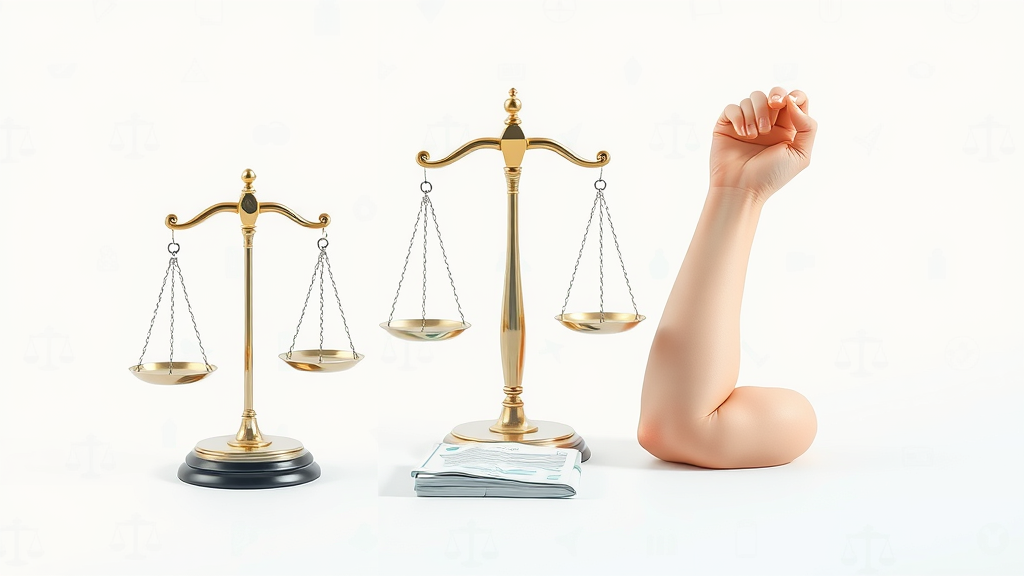Did you know over 39 million Americans receive medical attention for personal injuries yearly, resulting in billions in settlements? Yet, many injury victims miss out on rightful compensation due to mistakes or lack of knowledge about the claims process. This guide unveils quick relief tips and deep insights to help you claim what you deserve and make complex personal injury cases easier to navigate.
Unveiling the Truth: Surprising Facts about Personal Injury Compensation
Personal injury compensation is not just a legal right—it's a crucial tool for restoring financial stability after an injury case. Most people are surprised to learn that the majority of injury claims are settled out of court, with only about 4% going to trial. This means that understanding the nuances of compensation in personal injury cases can directly impact the speed and amount of your payout. Statistics also reveal that injury victims with professional legal representation often receive settlements up to three times higher than those without a personal injury lawyer. This underscores the importance of leveraging expertise when navigating injury law and insurance companies. In a world where medical expenses, lost wages, and even pain and suffering can leave lasting scars, knowing your rights and the real facts about injury compensation is vital for a fair recovery.

Why Personal Injury Compensation Matters in Modern Injury Cases
In modern injury cases, personal injury compensation does more than cover medical expenses—it's a lifeline for those facing sudden, life-altering disruptions. The increasing complexity of personal injury law and the rise in insurance company tactics have made it harder for the injured party to navigate claims alone. Swift, fair injury compensation can mean the difference between financial ruin and a secure future, especially when lost wages and ongoing therapy add up quickly after an accident or wrongful act. Additionally, as laws evolve and injury lawyers sharpen their negotiation skills, claimants now benefit more from skilled legal guidance than ever. Whether dealing with a car accident, property damage, or psychological distress, the right compensation ensures injury victims manage both immediate needs and long-term recovery, highlighting just how crucial these settlements are in today's world.
What You'll Learn About Personal Injury Compensation
- The different types of damages covered under personal injury law
- Steps to pursue a successful personal injury claim
- Essential considerations for maximizing your personal injury compensation
- Insights into how injury lawyers calculate and negotiate settlements
- Latest trends, statistics, and legal nuances in personal injury cases

Understanding Personal Injury Compensation and Its Impact
Grasping the essentials of personal injury compensation is critical for anyone pursuing an injury case or supporting an injured party. At its core, personal injury compensation aims to address the financial losses and emotional distress suffered due to someone else's negligence or intentional act. Over the past decade, the legal landscape surrounding injury law has become increasingly specialized, particularly as more injury victims seek fair outcomes. Legislators have updated personal injury laws, adding protections and clarity, but also new challenges in areas like comparative fault and insurance disputes. The true impact of compensation goes well beyond monetary awards—it restores dignity, covers ongoing therapy, and helps families regain control during stressful times. Understanding the available avenues, types of damages, and legal standards is key to making well-informed decisions and securing proper settlement amounts.
Personal Injury Law: The Foundation of Personal Injury Compensation
Personal injury law forms the backbone of injury compensation claims, providing the structure for injured parties to seek redress after an accident or wrongful act. This area of law establishes clear guidelines for what constitutes a valid injury claim, the evidence required, and the liability framework applied in injury cases. From car accidents and slips to severe incidents like wrongful death, personal injury laws are designed to ensure fairness and responsibility. In the United States, each state tailors its statutes, so knowing the local nuances of injury law is vital. This legal foundation also dictates the kinds of damages claimants can pursue, be it special damages for out-of-pocket costs or punitive damages against at-fault parties. Ultimately, personal injury law empowers injury lawyers and attorneys to advocate strongly for clients, ensuring that every facet of an injury case—economic loss, pain and suffering, and future care—is considered for just compensation.
How Injury Law Shapes Personal Injury Cases
Injury law doesn't just determine who was at fault—it shapes the entire journey of a personal injury case, from the initial claim filing to final settlement negotiations. It sets the protocols for evaluating economic damages such as medical expenses and lost wages, as well as non-economic damages like emotional distress or pain and suffering. Injury law outlines the legal standards used by insurance companies and courts to assess liability, comparative fault, and the overall value of an injury claim. As laws evolve, stronger protections for injured victims emerge—such as caps on punitive damages or new guidelines for documenting psychological harm. For those navigating personal injury cases, understanding these legal frameworks can greatly enhance their chances of success. Seasoned injury lawyers use the latest injury law updates to craft smarter arguments, accurately estimate damages, and negotiate assertively on behalf of their clients, ultimately making a meaningful difference in both process and outcome.
Key Participants: Personal Injury Lawyer, Injury Attorney, and Insurance Companies
Every personal injury case involves key players who shape the direction and outcome of the claim. Personal injury lawyers and injury attorneys serve as advocates for injury victims, guiding them through complex legal processes, managing documentation, and negotiating with insurance companies. Their expertise is invaluable in identifying eligible damages, proving liability, and ensuring injury victims do not fall for lowball offers from insurers. Insurance companies, on the other hand, employ adjusters and legal teams tasked with minimizing payouts; their primary goal is to resolve injury cases as inexpensively as possible. This dynamic often results in tough negotiations, highlighting the need for legal representation experienced in personal injury law. Injury lawyers also coordinate with medical professionals and vocational experts to build strong injury cases, while insurance companies thoroughly scrutinize every claim. A successful injury claim depends on having a capable personal injury attorney who can counter insurance strategies and ensure fair compensation.

Navigating the Steps in a Personal Injury Case
Successfully navigating a personal injury case requires understanding each critical step from the moment an accident occurs until compensation is received. The process starts with seeking immediate medical treatment and reporting the incident—a foundational move for both health and legal documentation. Next, collecting vital evidence such as accident reports, witness statements, photographs, and detailed records of financial loss sets the stage for a solid claim. Filing a personal injury claim within the applicable statute of limitations is crucial, as missing deadlines can jeopardize your right to compensation. Engaging a reputable personal injury lawyer early provides steady guidance, from evaluating your claim to negotiating with insurance companies and, if necessary, representing you in court. Throughout, diligent correspondence and follow-through help avoid common pitfalls, such as inconsistent statements or missed document submissions. With the right approach, injury victims increase their chances of a favorable settlement and a smoother recovery process.
Filing a Personal Injury Claim: Process and Timelines
The process of filing a personal injury claim begins immediately after an accident or injury occurs. Prompt action is critical, not only for medical attention but also to preserve evidence and protect your legal rights. Start by notifying the appropriate parties—this could be a property owner after a slip and fall, an employer for workplace injuries, or law enforcement in the case of a car accident. Documentation is essential: medical records, police reports, witness statements, and photographs all form the basis of your injury case. Most states have specific statutes of limitations—often ranging from one to three years—within which an injury claim must be filed, so it's vital to act swiftly. Once the claim is submitted, insurance companies review the evidence, assess liability, and propose a settlement offer. Injury lawyers assist by handling negotiations, preparing additional evidence, and, if necessary, initiating a personal injury lawsuit to fight for your compensation. Staying organized and proactive throughout this process ensures no critical deadline or detail is missed.
Role of Injury Lawyers and Personal Injury Attorneys
Injury lawyers and personal injury attorneys are indispensable allies in personal injury cases, protecting your rights and maximizing your recovery. They bring in-depth knowledge of injury law, evaluate the true value of your damages, and help you avoid the traps set by insurance companies. These legal professionals carefully review the specifics of your case, gathering extensive evidence to support your claim—from documenting physical injuries to quantifying lost wages and long-term effects. They negotiate assertively with insurance representatives, rejecting inadequate offers and pushing for settlements that reflect the full scope of your injuries. Should your case proceed to litigation, an experienced attorney prepares comprehensive legal arguments, leverages expert testimony, and presents your case powerfully in court. By hiring an injury lawyer early, claimants gain an advocate dedicated solely to their best interests—often resulting in significantly higher compensation than injury victims achieve alone.
Important Documents and Evidence in Injury Cases
Comprehensive documentation is the backbone of every successful personal injury claim. The most important documents include medical records detailing injury diagnoses and treatment plans, proof of lost wages from employers, receipts for out-of-pocket medical expenses, and detailed incident reports from authorities or property owners. Photographs of the injury, accident site, and property damage provide invaluable visual evidence. Expert testimonies, such as from doctors or accident reconstruction specialists, further substantiate your claims. Correspondence with insurance companies, notes from witness interviews, and a personal injury journal tracking pain and suffering all contribute to a robust injury case. Thorough documentation not only strengthens your negotiating position but also protects against disputes over liability or damages. Injury lawyers emphasize documenting every communication, expense, and recovery milestone—since a well-documented injury case increases the likelihood of fair personal injury compensation and a swift, satisfactory resolution.
Types of Damages in Personal Injury Compensation
Understanding the types of damages you can claim is essential for anyone seeking fair personal injury compensation. Damages in injury cases are typically divided into economic damages, which cover direct financial losses; non-economic damages for pain, suffering, or emotional distress; special damages for unique or unexpected costs; and punitive damages awarded to punish gross negligence or intentional harm. Injury lawyers help injured parties identify every applicable type of damage to maximize their claim's value. This comprehensive approach considers both immediate costs—like medical bills or property repair—and long-term needs, such as ongoing therapy, lost earning capacity, and diminished quality of life. By understanding all the ways personal injury affects their lives, injury victims set more realistic expectations and improve their negotiating leverage when dealing with insurance companies or preparing for a personal injury lawsuit.
Economic Damages: Medical Expenses, Lost Wages & More
Economic damages are tangible financial losses that result directly from an accident or injury and form the foundation for most personal injury compensation. These include all medical expenses—from emergency room visits, surgeries, and prescription medications to physical therapy and future care costs. One of the most pressing concerns for injury victims is lost wages, representing income not earned during recovery. Additional economic damages may involve property damage repairs (such as in a car accident case), transportation costs for medical appointments, and the costs of hiring assistance at home. Clear documentation of all financial outlays is crucial, as insurance companies closely scrutinize these claims. Injury lawyers work with clients to ensure every expense—past, present, and projected—is accounted for, maximizing the amount of compensation awarded and restoring financial stability to the injured party.
Non-Economic Damages: Pain and Suffering Explained
Unlike economic damages, non-economic damages address the intangible impact of an injury case, focusing on pain and suffering, emotional distress, loss of consortium, and diminished enjoyment of life. Calculating the value of these losses is inherently subjective, often relying on the severity and duration of pain, psychological trauma, the extent of permanent physical limitations, and lifestyle changes attributable to the injury. Injury lawyers use medical records, expert testimony, and personal injury journals to build a compelling case for these non-economic losses. Courts and insurance companies consider factors such as the type of injury, length of recovery, and the injury victim’s pre-accident lifestyle when determining fair compensation. Though non-economic damages can vary widely by injury case and jurisdiction, they regularly account for a substantial portion of total compensation, especially in severe or life-altering injuries.
Special Damages vs. Punitive Damages in Personal Injury Cases
Special damages refer to unique, out-of-the-ordinary financial losses not covered by standard economic calculations. This can include travel expenses for specialized treatment, adaptive home modifications, or anticipated future medical interventions. Injury lawyers meticulously document such losses to ensure the injured party receives reimbursement for every expense incurred as a direct result of the injury event. Punitive damages, in contrast, are not meant to compensate the injured party for losses but to punish egregious misconduct or gross negligence by the at-fault party and deter similar actions in the future. Punitive damages are more common in personal injury cases involving intentional harm, fraud, or reckless endangerment, and are subject to strict legal thresholds. While courts award them in limited circumstances, their presence can dramatically increase the settlement value, sending a clear message about the consequences of such conduct. Together, special and punitive damages reinforce justice and accountability within injury law.
| Economic Damages | Non-Economic Damages |
|---|---|
| Medical expenses, lost wages, property damage, rehabilitation costs | Pain and suffering, emotional distress, loss of enjoyment, loss of consortium |
| Tangible, easily documented with receipts and statements | Intangible, calculated using severity and impact on daily life |
| Often capped by actual loss; calculated precisely | Subjective valuation, varies by jurisdiction and judge/jury |

Quick Relief Tips: Maximizing Your Personal Injury Compensation
- Seek immediate medical attention—document everything: Early treatment creates an official injury record, strengthening your case.
- Contact a reputable personal injury lawyer early: Prompt legal representation increases the chances of maximizing your settlement.
- Accurately track all medical expenses and lost wages: Keep receipts, invoices, pay stubs, and detailed notes to establish your financial losses.
- Avoid discussing the injury case publicly or on social media: Insurers and opposing counsel may use your statements against you.
- Follow up diligently on all legal and insurance correspondence: Timely responses prevent missed deadlines and strengthen your claim’s credibility.
"Effective documentation can be the difference between fair personal injury compensation and a lost cause.” — Leading Injury Attorney

Factors That Influence Personal Injury Compensation Amounts
Several key factors determine the final amount of personal injury compensation in any injury case. The most influential is the severity of your injuries and their long-term effects on your quality of life and ability to work. Courts and insurance companies consider medical prognosis, future care needs, and permanent disabilities. Liability and comparative fault play a major role; if the injured party is partly responsible, compensation may be reduced. Insurance policy limits set a ceiling on payouts, while skilled legal negotiation can help maximize settlements within those limits. Other influences include the strength of documentation, consistency in your case narrative, credibility of witnesses, and even the local legal climate. Being aware of these variables and working closely with a qualified injury lawyer ensures you’re positioned for the highest fair settlement possible.
Severity of Injuries and Long-term Effects
The extent and permanence of injuries are substantial drivers of personal injury compensation. Severe injuries—such as traumatic brain injuries, spinal cord damage, or chronic pain conditions—often require costly long-term care and may limit an individual's ability to work, resulting in ongoing lost wages. Courts and insurance adjusters analyze the medical documentation, expert testimony on long-term prognosis, and the projected impact on daily living. Visible, debilitating injuries or those needing repeated medical treatments typically command higher settlement amounts. Injury lawyers help quantify these expenses and forecast future financial needs, ensuring that compensation reflects not just immediate losses but the real, lasting impact on the injured party’s life. In every case, meticulous documentation of symptoms, treatments, and limitations is vital to support the highest possible claim value.
Liability and Comparative Fault in Injury Law
Liability—the determination of who was at fault—and comparative fault are pivotal elements in personal injury cases. In states following pure comparative fault rules, the injured party’s compensation is reduced by their percentage of fault. For example, if a plaintiff is found 20% responsible in a car accident, their recovery is reduced accordingly. Accurate allocation of fault depends on police reports, accident reconstruction, witness statements, and physical evidence. Disputes over liability are common, especially in complex injury cases or multi-party incidents. A skilled personal injury lawyer can assemble a persuasive case to minimize a claimant’s share of blame and maximize compensation. Understanding these legal principles and how they apply to your injury case is essential for a successful settlement or verdict.
Insurance Policy Limits and Negotiation Tactics
Insurance policy limits define the maximum available for injury compensation through a defendant’s insurance. Even if damages exceed this cap, insurers cannot pay more than the policy allows—any remaining amount may need to be pursued directly from the at-fault party. Astute negotiation is critical here; injury lawyers employ demand letters, meticulously detailed evidence, and strategic timing to secure policy-limit settlements or pressure defendants into higher offers. Knowing the insurance landscape—company policies, industry settlement practices, and the local appetite for jury awards—enables attorneys to negotiate effectively. Injury victims should never accept a first offer from insurance companies; consulting a personal injury attorney ensures that negotiation tactics are tailored to maximize recovery within real-world constraints.

People Also Ask: Insights into Personal Injury Compensation
How much do most personal injury cases settle for?
Answer: Settlement amounts vary tremendously, often ranging from several thousand dollars for minor injury claims to millions for severe personal injury cases depending on liability, economic damages, pain and suffering, and insurance coverage.
How much compensation do you get for personal injury?
Answer: Personal injury compensation is based on a combination of your medical expenses, lost wages, pain and suffering, and associated special damages related to the injury case.
Who gets paid first in a personal injury settlement?
Answer: Typically, outstanding medical bills and liens are paid first from personal injury settlements, followed by legal fees for personal injury lawyers and then the injured party receives their portion.
What is the average payout for compensation?
Answer: Average personal injury compensation varies by injury case type, with some analyses suggesting most injury claims settle between $3,000 and $75,000, but extremes exist for catastrophic injury cases.
Frequently Asked Questions on Personal Injury Compensation
-
How long do personal injury claims usually take to resolve?
Most claims settle within several months, but complex cases involving severe injuries or disputed liability may take a year or more, especially if litigation is necessary. -
What types of injuries qualify for personal injury compensation?
Any injury caused by another's negligence or wrongful act—including car accidents, slips, workplace incidents, and even psychological distress—may qualify. -
Can I claim for psychological distress in addition to physical injury?
Yes; emotional distress, pain and suffering, and loss of enjoyment can be included in your claim alongside physical injuries, if well documented. -
Will hiring an injury lawyer improve my settlement amount?
Studies consistently show that injury victims with legal representation recover higher settlements by avoiding common pitfalls and negotiating more effectively. -
Do all injury cases go to court or can they be settled out of court?
The vast majority—over 90%—of personal injury cases are settled out of court via negotiation, mediation, or arbitration rather than litigation.
Key Takeaways: What Matters Most in Personal Injury Compensation
- Quick action and best practice documentation increase compensation
- Choosing a specialized personal injury attorney is critical
- Understanding types of damages helps set realistic expectations
- Most personal injury cases settle out of court through negotiation
Summary and Next Steps on Personal Injury Compensation
Take proactive steps now to secure the personal injury compensation you deserve. Learn more: visit pugetsoundinjurylaw.com/.
Understanding personal injury compensation is crucial for anyone navigating the aftermath of an injury caused by another’s negligence. The American Bar Association’s article, “Personal Injury Claims,” provides a comprehensive overview of what to expect when pursuing such claims, including potential damages and the legal process involved. Additionally, the Wikipedia entry on “Personal Injury” offers detailed insights into the types of injuries covered, legal considerations, and compensation structures. These resources are invaluable for anyone seeking to understand their rights and the intricacies of personal injury compensation.
 Add Row
Add Row  Add
Add 




Write A Comment